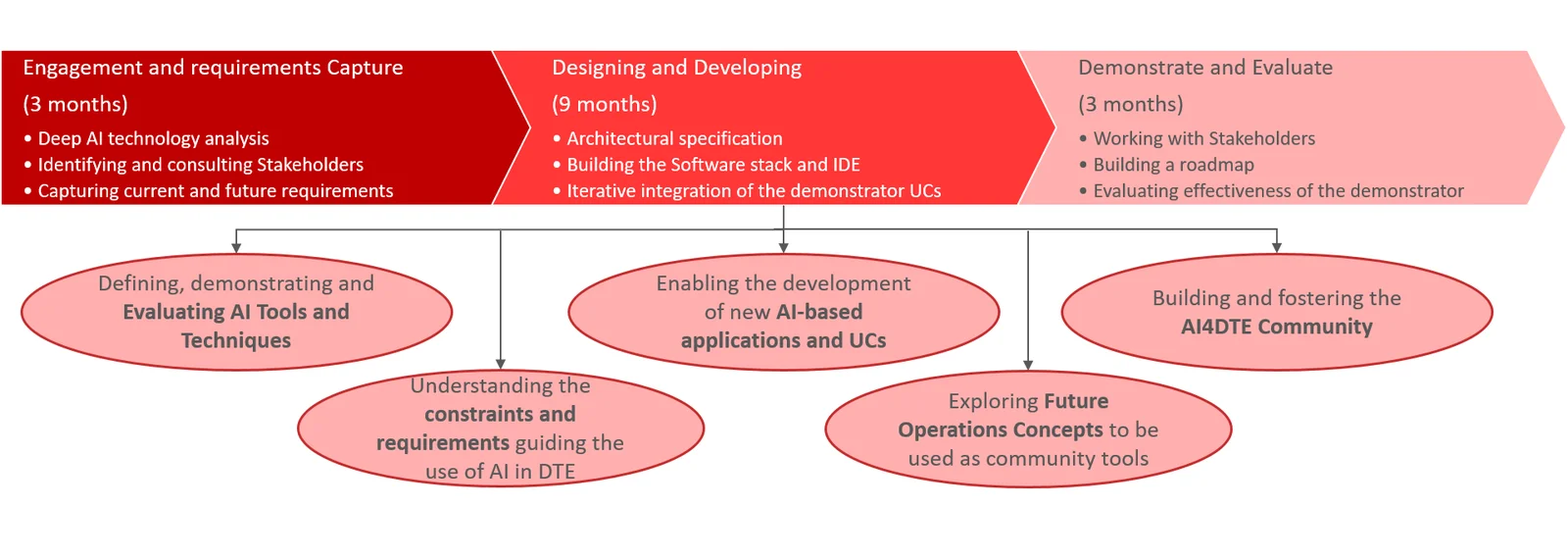
AI4DTE Software Stack
AI4DTE Software Stack is a 15 month project sponsored by European Space Agency to develop and demonstrate a prototype cloud-based platform for AI-enabled applications, in the context of the Digital Twin Earth initiative.
This project aims to deliver the starting point for a core AI-infrastructure that can be used in multiple Digital Twin Earth (DTE) developments. It will provide a representative set of tools and resources relevant to AI-based developments, and demonstrate their use through three DTE use cases. As such the DTE use cases in this activity are to be understood as a tool to demonstrate the value of the AI software stack applied to likely DTE use scenarios. The SW stack and IDE output from this activity are expected to be extensible, to allow developing a growing set of capabilities, which will be completed and operationalized outside the scope of this project.
Summary
Digital Twins of the Earth address decision support under uncertainty, providing a prognostic, evidence-based decision support capability representing the dynamic relationships between the physical and natural environments (the Earth System) and society (such as socioeconomic pathways, adaptation and mitigation actions or governance). In accordance with this vision, the uses cases that may be envisioned for the digital twins must provide, inter alia:
- Quantifiable and comparable impact predictions in the Earth System and/or downstream impact sectors';
- Actionable information and evidence-based decision support based on comparison of predicted impacts resulting from varying initial conditions;
- Support to ex-ante Impact Assessment in the form of what-if scenario analysis; and in addition;
- Must be explainable in major steps of modelling and simulations, enabling model inspection and user interpretation; and
- Estimate and propagate uncertainty relevant to users (e.g. for policy makers uncertainty could refer to the confidence levels of a predictive capability of a simulation) in all steps of the use case.
AI will provide many fundamental building blocks at the data, modelling, and reasoning levels of the digital twins. Accordingly, the objectives of the AI4DTE SW stack project are to:
- Refine the understanding of constraints and requirements guiding the use of AI in DTE, and identify opportunities, risks, limitations and needs for further research and development;
- Develop, demonstrate and evaluate AI tools and techniques implementing the requirements and constraints for the use of AI in DTE;
- Set the stage for future operationalization of AI/ML capabilities and community tools required in DTE in the medium- (2-3 years) and longer-term (3-6 years);
- Enable a DTE user community to develop new AI-based applications and use cases for a variety of Earth System Models and DTs;
- Explore future operations concepts, such as iterative AI active learning pipelines (MLOps), to be used as community tools, including continuous feedback and update of input data and software, for future integration in more operational and constrained DestinE environments,
- Build and foster a community of AI4DTE solution providers and establish partnerships with ESM and DestinE user communities.
In this context, the AI4DTE SW stack project will:
- Design, develop and deliver an AI4DTE SW Stack containing a representative subset of AI capabilities relevant to DTE across the data layer, the model layer and the decision support layer;
- Deliver an AI4DTE Integrated Development Environment (IDE) for demonstration purposes providing access to the AI4DTE SW Stack, allowing for the development and execution of AI-based DTE applications and use cases;
- Develop and deliver at least 2 DTE use cases based on the capabilities provided in the AI4DTE SW stack and IDE;
- Define and conduct a Pilot Demonstration Campaign, bringing together a small group of pilot users for a brief period of time, execute a demo aimed at showing full use of the system capability in a real-world albeit simulated context and capture results;
- Evaluate principles, opportunities, requirements, constraints and limitations of the use of AI in DTE, refine the concept and deliver a roadmap for further development advancing the state of the art and operationalization of AI4DTE;
- Engage and build partnerships with the AI4DTE provider and impact sector user communities.

This website is organised in five sections:
- Team, where the project partners are presented;
- Software Stack, where the software stack concept is introduced;
- Use Cases, where the three use cases are summarised and linked to a page per use case with more details;
- Stakeholders, where the stakeholder are listed;
- News, where the social media announcements are summarized.